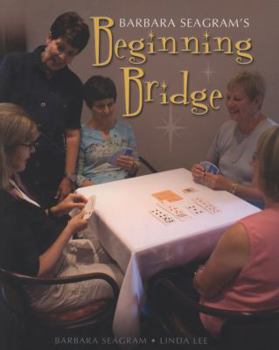Beginning Bridge
Select Format
Select Condition 
Book Overview
Written for complete beginners, this book is based on material that Barbara Seagram uses in her own classes to introduce hundreds of new players to the game every year. The book will take readers to... This description may be from another edition of this product.
Format:Paperback
Language:English
ISBN:1897106335
ISBN13:9781897106334
Release Date:June 2008
Publisher:Master Point Press
Length:218 Pages
Weight:1.01 lbs.
Dimensions:0.6" x 7.4" x 9.1"
Customer Reviews
2 ratings
Specifically designed to teach beginners the fundamentals of the game
Published by Thriftbooks.com User , 16 years ago
Bridge is one of America's most popular indoor pastimes for adults of all ages and backgrounds. From social home games to competitive state and national tournaments, Bridge is a sophisticated, complex, challenging, and entertaining pastime whose only requirements are a deck of cards and a table. Expertly co-authored by Barbara Seagram (one of North America's best-known bridge teachers and author of numerous books on the game), and Linda Lee (a WBF World Master and Bridge journalist, "Beginning Bridge" is specifically designed to teach beginners the fundamentals of the game and cover every aspect of Bridge including bidding, declarer play, defensive cardplay, and scoring. Enhanced with 'user friendly' tips, stories, and quizzes to reinforce and illustrate card game instructions, "Beginning Bridge" is enhanced further with the occasional cartoon drawings of Karen Lampert. "Beginning Bridge" is a core addition to school and community library Gaming reference collections and an ideal beginner's manual for the non-specialist general reader wanting to learn the fundamentals of this popular pastime.
Beginning Bridge
Published by Thriftbooks.com User , 16 years ago
This book is likely to be highly rated by ACBL and ABTA and may well be the best of its kind. And yet, it has some glaring shortcommings. First there is no index, only a Glossary without any page references.It does not recognize the ten card(T) as an honor card nor does it mention the Rule of 20, which is in the text. Next, every student needs to be made aware that there are primary, A and K, and secondary(Q,J and T)honor cards. Most bridge books will tell you that the primary honors are slightly undervaued on the Work-Goren point count scale,while the secondary ones are a bit overvalued.Thus unless a hand has an equal number of each kind an adjustment needs to be made in the HCP count. This difference can be expressed in terms of quick tricks, which come from combinations of A,K and Q, and has been part of hand evaluation during the past century. But this valuable concept is not mentioned. In addition there are a few other changes to the point count recommended by the master players and teachers of the old school but now left out as too hard for beginners to learn.This is part of an ongoing effort to dumb down education in all forms of teaching in the hope of attracting more students. A hand is also evaluated interms of its shape and distribution of number of cards per suit. For a long time during the past century there were two methods used, viz. the Goren short suit count, (1-2-3) and the Karpin long suit count of 1 pt for each card over 4 in any suit, with the first having been most popular, but gradually replaced by the Karpin count, so that ACBL favors it and is now used by the majority of players. Most new books now use it. This book mentions both as yielding about the same results most of the time and is illustrated with hands where there is no difference. Strictly speaking, 99.5% of all hand patterns cover 23 of the 39 possible patterns, but only 7of them yield identical counts, while 14 differ by one pt and two (4-4-4-1 and 5-4-4-0) differ by two pts. The world class player and prolific bridge author E.Kantar warns against the short suit count in "Bridge for Dummies" with this sage advice: 'Some bridge players fall in love with singletons and voids. They love them so much that they count extra points for them right off the bat. Do everything you can to avoid becomming one of them. They are a tradgedy waiting to happen, because they fail to appreciate that short suits are good only when you have support for your partner's suit. You need a good fit before you can count extra points for short suits." Thus Kantar has adopted to old saying "Don't count your chickens before they are hatched". There is no compelling reason for using the short suit count, when the majority of teachers and students use the long suit count.But knowing about it can be helpful when playing with a new partner. Also, the short suit count tends to get confused with "dummy poins". It is unrealistic to count points for shortness in the major suits, when t






